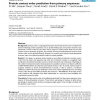84 search results - page 8 / 17 » The Context-Dependence of Amino Acid Properties |
BMCBI
2006
13 years 7 months ago
2006
Background: Despite the current availability of several hundreds of thousands of amino acid sequences, more than 36% of the enzyme activities (EC numbers) defined by the Nomenclat...
BIBM
2007
IEEE
14 years 1 months ago
2007
IEEE
We analyzed the structural properties and the local surface environment of surface amino acid residues of proteins using a large, non-redundant dataset of 2383 protein chains in d...
CSB
2005
IEEE
14 years 1 months ago
2005
IEEE
The ability to predict antigenic sites on proteins is crucial for the production of synthetic peptide vaccines and synthetic peptide probes of antibody structure. Large number of ...
ICASSP
2009
IEEE
14 years 2 months ago
2009
IEEE
Correct prediction of signal peptide cleavage sites has a significant impact on drug design. State-of-the-art approaches to cleavage site prediction typically use generative mode...
BMCBI
2008
13 years 7 months ago
2008
Background: Contact order is a topological descriptor that has been shown to be correlated with several interesting protein properties such as protein folding rates and protein tr...


